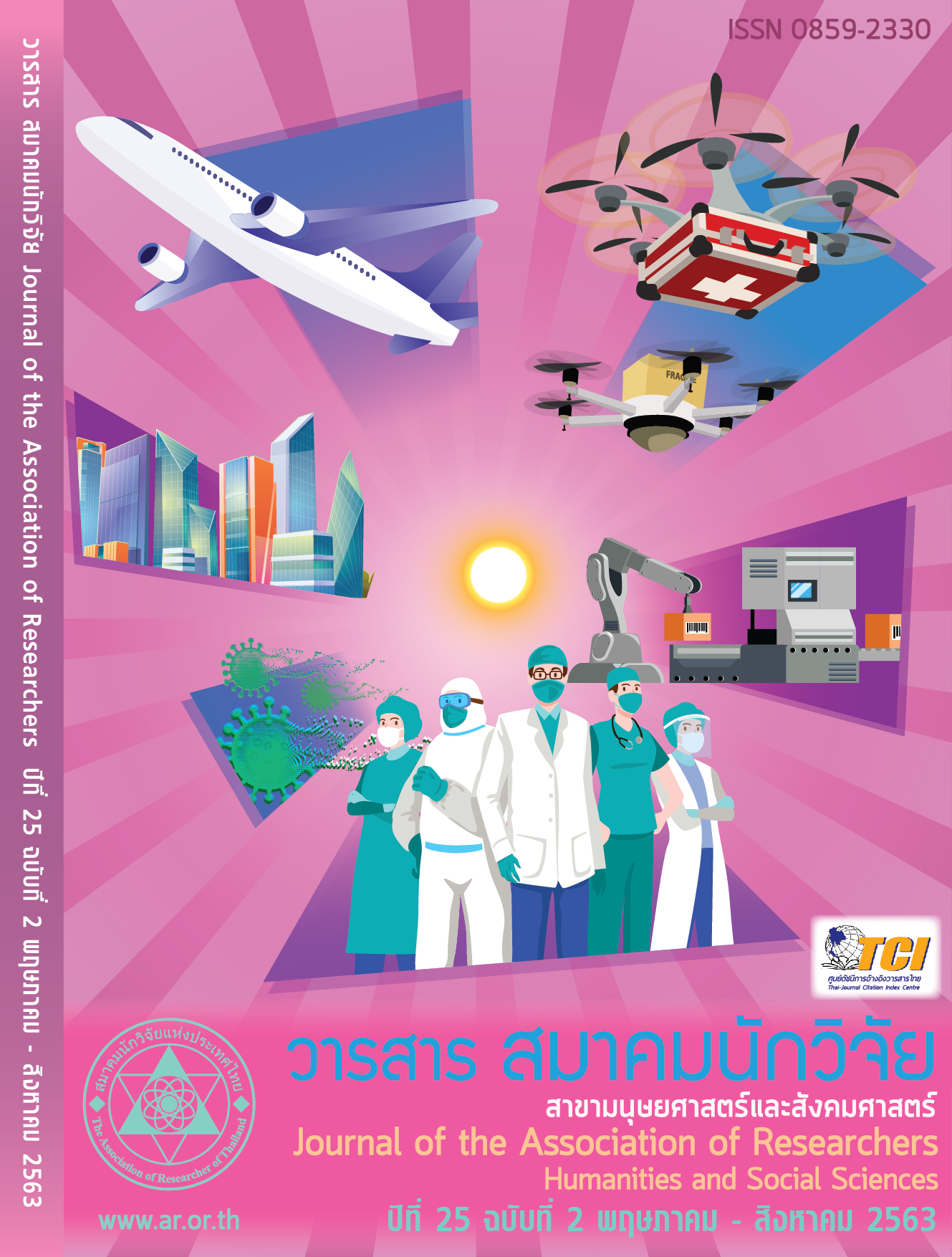Influences of Transformational Leadership and Corporate Social Responsibility on Corporate Image: A Case Study of Employees’ Perceptions of Inter Cleaning Supplies Co., Ltd.
Main Article Content
Abstract
The purposes of this research were 1) to study of the structural relationship between transformation leadership corporate social responsibility and corporate image of Anantara Hotel 2) to study the influence of transformation leadership on corporate social responsibility 3) to study the influence transformation leadership on corporate image both direct and indirect via corporate social responsibility and 4.) to study the influence of corporate social responsibility on Corporate Image: Employees’ Perceptions of Inter Cleaning Supplies Co., Ltd. The Samples were 300 employees.
The research results found that 1) the correlation coefficient among observable variables was 0.501 - 0.779 and every variable had a significant level. 2) transformation leadership had a direct effect on corporate social responsibility at a very high level at the statistical significance and variance predicted by transformation leadership with 53 percent. 3) transformation leadership had directly affected the corporate image at a low level at the statistical significance and had indirect effect via corporate social responsibility in lower at the statistical significance and variance predicted by transformation leadership with 59 percent. And 4) corporate social responsibility had an effect on a corporate image at a high level at the statistical significance. Fit indices of the model were χ2 / df = 1.84, CFI = 0.99, NNFI = 0.99, RMSEA = 0.046, SRMR = 0.0022 and 90% CI for RMSEA = 0.00.
Article Details
บทความที่ปรากฏในวารสารนี้ เป็นความรับผิดชอบของผู้เขียน ซึ่งสมาคมนักวิจัยไม่จำเป็นต้องเห็นด้วยเสมอไป การนำเสนอผลงานวิจัยและบทความในวารสารนี้ไปเผยแพร่สามารถกระทำได้ โดยระบุแหล่งอ้างอิงจาก "วารสารสมาคมนักวิจัย"
References
ปฏิมา ถนิมกาญจน์ นรรัฐ รื่นกวี และ เพ็ญพร ปุกหุต. (2561). “อิทธิพลของผู้นำเชิงปฏิรูปและวัฒนธรรมองค์การที่ส่งผลต่อการลาออกของบุคลากรในหน่วยงานภาครัฐบาล รัฐวิสาหกิจ และภาคเอกชน.” วารสารสมาคมนักวิจัย 23 (2): 89-102.
พิพัฒน์ นนทนาธรณ์. (2553). การจัดการความรับผิดชอบต่อสังคมขององค์กร: การสร้างข้อได้เปรียบทางการแข่งขันอย่างยั่งยืน. นนทบุรี: ธิงค์ บียอนด์ บุ๊คส์.
__________ (2556). ภาวะผู้นำเชิงปฏิบัติการ: LIFE Model. กรุงเทพฯ: ศูนย์ผู้นำธุรกิจเพื่อสังคม.
โอภาส วิริยะสกุลธรณ์ และ พิพัฒน์ นนทนาธรณ์. (2561). “อิทธิพลของภาวะผู้นำที่รับผิดชอบต่อสังคมและคุณภาพการบริการที่มีผลต่อภาพลักษณ์องค์การของอนันตรา ริเวอร์ไซด์ กรุงเทพฯ รีสอร์ท.” วารสารสมาคมนักวิจัย 23 (3): 52-63.
Bass, B. M. & Avolio, B. J. (1994). Improving Organizational Effectiveness through Transformational Leadership. Thousand Oaks, CA: Sage Publications.
Carroll, A. B. (1999). Corporate social responsibility evolution of a definitional construct. Business & Society 38(3), 268-295.
Certo, S. C. (2003). Modern Management. Upper Saddle River, NJ: Prentice-Hall.
Cheney, G., and S. L. Vibbert. 1987. Corporate Discourse: Public relations and issue management. Newbury Park, CA: Sage.
Dessler, G. (1998). Management: Leading People & Organizations in the 21st Century. Canada: Prentice-Hall.
Dutton, J. E., J. M. Dukerich, and Harquail, C. V. (1994). Organizational images and member identification. Administrative Science Quarterly 39: 239-263.
Grant, S.E. & Powell, D. (1999). Crisis response & communication planning manual. Ontario Ministry of Agriculture, Food, and Rural Affairs. Retrieved from http://www.foodsafetynetwork.ca/crisis/crisis-manual.htm
Hooper, D., Coughlan, J., & Mullen, M. (2008). “Structural Equation Modeling: Guidelines for Determining Model Fit.” Electronic Journal of Business Research Methods 6 (1): 53-60.
Leech, N. L., Barrett, K. C., & Morgan, G. A. (2005). SPSS for Intermediate Statistics: Use and Interpretation (2nd ed.). Mahwah, NJ: Lawrence Erlbaum Associates.
Moffitt, M. A. (1994). Collapsing and integrating concepts of ‘public’ and ‘image’ into a new theory. Public Relations Review 20 (2): 159-170.
Mushinsky, P. M. (1997). Psychology applied to work an introduction to industrial and organizational psychology. California: Brooks/Cole.
Seitel, S. (2007). The Practice of Public Relations (10th ed.). NJ: Practice- Hall.
Nonthanathorn, P. (2010). Corporate = social responsibility management: creating a sustainable competitive advantage. Nonthaburi: Think Beyond Book. (in Thai).
________ (2013). Operational Leadership: LIFE Model. Bangkok: Social Enterprise Leadership Center. (in Thai).
Suebsai, K., and Nonthanathorn, P. (2017). “Influences of Strategic Leadership and Corporate Social Responsibility on Corporate Image King Power International Company Limited.” Journal of the Association of Researchers22 (3): 96-107. (in Thai).
Tanimkarn, P., Runkawee, N., and Pukahuta, P. (2018). “The Influence of Transformational Leadership and Organizational Culture on the Resignation of Staff of Government Agencies, State Enterprises, and Private.” Journal of the Association of Researchers 23 (2): 89-102. (in Thai).
Viriyasakultorn, O., and Nonthanathorn, P. (2018). “Influences of Socially Responsible Leadership and Service Quality on Corporate Image of Anantara Riverside Bangkok Resort.” Journal of the Association of Researchers 23 (3): 52-63. (in Thai).


